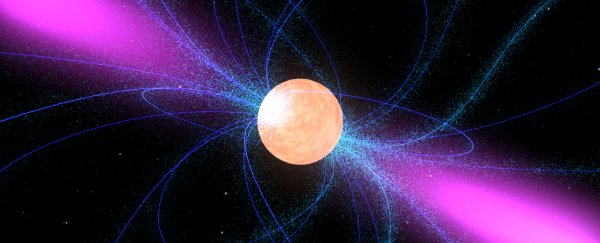Far out in the Milky Way, roughly 22,000 light years from Earth, a star unlike any other roars with a magnetic force that beats anything physicists have ever seen.
At a whopping 1.6 billion Tesla, a pulsar called Swift J0243.6+6124 smashes the previous records of around 1 billion Tesla, discovered surrounding the pulsars GRO J1008-57 and 1A 0535+262.
For a bit of context, your average novelty fridge magnet comes in at around 0.001 Tesla. The more powerful MRI machines manage to hit around 3 Tesla.
A few years ago, engineers earned a pat on the back for achieving a semi-respectable 1,200 Tesla, sustaining it for a blink of just 100 microseconds.
So it stands to reason that 1.6 billion Tesla is going to demand some truly mind-blowing physics. The kind only achievable by massive objects crammed into impossible volumes and spun at incredible speeds, fast enough to accelerate electrons to ridiculous velocities.
Swift J0243.6+6124 was already regarded as a star worth paying attention to. A type of super-compact cosmic heavyweight known as a pulsar, it's the only X-ray source in our galaxy to fall into the ultra-luminous category.
It's also the only example in the Milky Way of an X-ray pulsar with a Be-type companion star feeding it matter fast enough to generate radio-emitting jets of matter from its poles.
Those features alone add up to a unique opportunity in our galactic backyard astronomers can't help but study in detail.
Measuring the magnetic field of a far-distant object is easier said than done, though. As strong as they are, those fields quickly weaken to become undetectable over distances of thousands of light years.
Fortunately clues can be found in the way that the ultra-bright glow of X-rays scatters from the electrons whizzing down the magnetic racetrack, something known as a cyclotron resonance scattering feature.
China's launch of the X-ray observatory Insight-HXMT in 2017 provides astrophysicists with a way to capture signatures like these in distant emissions, leading to the measure of electron energies in the GRO J1008-57 field in 2020.
Fortunately, an outburst of activity in Swift J0243.6+6124 following Insight-HXMT's launch also provided a glimpse into its own high-strength magnetic field, with a cyclotron resonance scattering feature buried within its X-ray spectrum.
Researchers from the Chinese Academy of Sciences and Sun Yat-Sen University in China, and the University of Tübingen in Germany, subsequently analyzed the feature to calculate the energy of its electrons to peak at an astonishing 146 kiloelectron volts, blitzing the 90 and 100 kiloelectron volts of the previous record holders.
Given Swift J0243.6+6124 is the only ultra-luminescent X-ray pulsar in our galaxy, having a precise measure on its magnetic field gives astronomers a better idea of what might be happening close to its surface.
As a type of neutron star, pulsars like Swift J0243.6+6124 are made of atoms squished into configurations far beyond anything we can create on Earth. Its magnetic properties help exclude or support various models that explain how its highly compact crust behaves.
Specifically, the nature of the neutron star's magnetism confirms the likelihood that its field is complex, consisting of multiple poles.
That's a solid win for astrophysicists keen to understand the mysteries of some of the most exotic objects in space.
For the rest of us, it's enough just to try to imagine the might of a 1.6 billion Tesla magnet stuck to our fridge.
This research was published in The Astrophysical Journal Letters.
